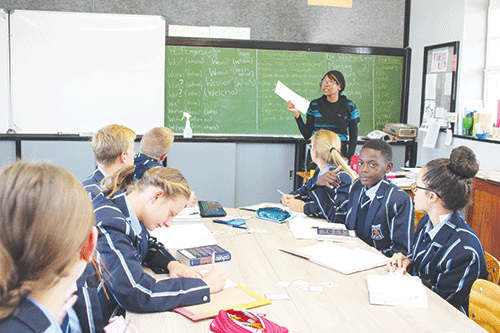The National Council Standing Committee on Education, Science, ICT and Youth Development has urged the government to maximise its budget towards training of teachers and resourcing schools with the necessary materials for the new curriculum to be effective.
The committee noted with concern the lack of prescribed textbooks for the syllabi, consumables for the pre-vocational subjects as well as functional laboratories across the schools.
Furthermore, the education ministry has been advised to consider reverting to three terms instead of the current two school terms as the content of the revised curriculum demands more teaching and learning time.
These were some of the parliamentary standing committee’s recommendations tabled in the National Council Chamber yesterday.
This follows a fact-finding mission from July to September last year on the high failure rate of learners in the Namibia Senior Secondary Certificate Ordinary and Namibia Senior Secondary Certificate Advanced Subsidiary national examination levels.
Presenting the report, committee chairperson Olivia Tuyenikelao Hanghuwo told her peers that various stakeholders on education and youth development questioned the grounds on which the government through the ministry of education endorsed the new school curriculum, saying its “flaws resulted in the high failure rate and increase on the school dropouts”.
Hanghuwo said during the committee’s public consultation meetings carried out in 14 regions, some members of the public pointed out that the roll-out of the curriculum was poorly planned, lacked wide and proper consultation and it was not well resourced.
“It was evident through the consultation that stakeholders and schools alike were not ready for a revised curriculum. Besides that, teachers were not adequately trained to effectively implement the curriculum that is perceived to be time demanding than what teachers currently offer,” Hanghuwo said.
She indicated that most of the schools were not provided with the necessary tools such as textbooks, fully equipped science and computer laboratories, or kitchen appliances for home science subjects.
A lack of essential equipment was also noted for practical subjects such as agriculture, geography, biology, chemistry and physical science as well as all pre-vocational subjects such as motor mechanics and woodwork.
Hanghuwo said those that attended the consultation meetings argued that the country was not ready for a new curriculum reform.
“The curriculum was not piloted; it was just implemented without due diligence and teachers were not ready as many of them are still unqualified and they are forced to teach subjects they are not competent in,” Hanghuwo revealed.
Furthermore, the committee noted that the AS curriculum is meant to be taught over 18 months and schools tried to complete it in eight months, and without afternoon classes it was hard to complete the syllabus. Some teachers claimed they are not equipped to teach at this level.
Three terms
Hence, the committee recommended that the ministry should consider reverting to three terms instead of two as the content of the revised curriculum demands more teaching and learning time.
The committee also picked up that there is no coordination between the implementers and the initiators of the curriculum and that there is, therefore, a disconnect resulting in everyone pulling in their own direction.
It established that the curriculum is ICT based but it is struggling to work in most of the schools due to limited resources currently experienced by an overwhelming majority of many schools.
The committee further noted a mismatch between AS and tertiary requirements. “For instance, 28 points in grade 11 without the minimum three Cs would not qualify a learner to AS level but 18 points with three Cs an E in English and remain Us would get a learner to proceed to AS,” the report reads.
Also, the calculus topic in Mathematics was only introduced in AS level, which caused a challenge for many learners.
“Therefore, it was recommended that the developers bring down the basic of calculus to lower grades in order for learners to familiarise themselves at an earlier stage with some of the concept.”
Teacher: learner ratio
Lawmakers revealed that the policy on Staffing Norms in terms of teacher to learner ration has not been enforced.
“Majority of schools visited were way over the prescribed staffing norm of 30 learners per teacher. As a result, most of the schools visited have between 40 and 70 learners in one classroom,” Hanghuwo noted.
According to Hanghuwo, overcrowding in classrooms was confirmed to be one of the major causes of high failure, as the learners are not given the necessary individual attention.
Meanwhile, the report has indicated that the ministry has acknowledged the issue of overcrowding classrooms and informed the committee that funds were secured from the European Union to construct about 150 classrooms, mainly targeting primary schools.
Consultations
Education executive director Sanet Steenkamp, in an earlier interview with New Era, denied the allegations that the stakeholders and public in general were not consulted on the development of the new curriculum that was implemented in 2021.
According to Steenkamp, the ministry carries out the introspection and consistently evaluates the education system in order to ensure that the curriculum speaks to the new development in society.
She said this evaluation also includes the needs of the economy to adequately prepare learners academically and technically.
The ED said stakeholder consultations on the new curriculum were done through print, electronic media and oral presentations countrywide in the year 2013.
“We had focused discussions with members of the teachers’ unions, students’ representatives, parents and learners as well as representatives from the public sector and institutions of high learning,” Steenkamp said.
She emphasised that the new curriculum is in line with the national conference on education supported by Cabinet directives.
Asked for her take on the perception that the new curriculum is the cause of high failure rate, Steenkamp said: “This may not be entirely correct, but looking at the previous data and statistics, there is indeed an improvement in the results produced in 2023 compared to the previous 2022 from 14% to 29% for learners qualifying for NSSCO to AS”.
- lnashuuta@gmail.com
Photo: New Curriculum
Caption:


